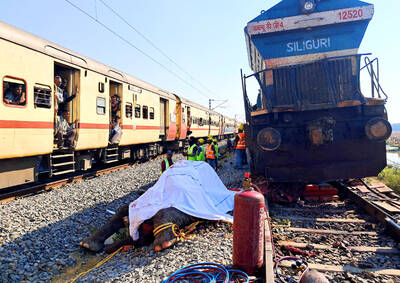Finland’s security and intelligence service SUPO is closely watching how US intelligence positions itself toward Russia under US President Donald Trump’s administration, its head said yesterday.
SUPO yesterday published a national security review in which it named Russia as the biggest threat to Finland, which shares a 1,340km border with Russia and joined Western military alliance NATO in 2023 in response to Moscow’s invasion of Ukraine.
Trump has paused military aid to Ukraine following his clash with Ukrainian President Volodymyr Zelenskiy last week and has adopted a more conciliatory stance toward Moscow.

Photo: Reuters
Asked by reporters if the US could still be trusted as an intelligence ally, SUPO Director Juha Martelius said information exchanges continued as before.
“Of course, this is a development that we are following very closely. And of course, so are other intelligence and security services in Europe that are allies of the United States,” he told reporters.
Martelius said Trump’s rapprochement with Russia had not yet had an impact on intelligence cooperation on a practical level.
“If it seems that the United States’ interest in directing its actions to concretely counter Russia is waning, then it is clear that each Western actor must consider new forms of cooperation and also further development of their own efforts,” he said.
In its review, SUPO said the security threat posed by Russia against Finland and Europe would continue to grow, even if the war in Ukraine came to an end.
“When the war in Ukraine ends, Russia’s resources will be freed up for influence elsewhere,” it said.
Martelius added that the frequency of cable incidents in the Baltic Sea has been “exceptional” in recent years, but state actors have more effective ways of performing underwater sabotage than by dragging anchors.
The Baltic Sea region is on high alert after a string of power cable, telecom link and gas pipeline outages since Russia invaded Ukraine in 2022, and NATO has boosted its presence with frigates, aircraft and naval drones.
On Sunday, Finland released the oil tanker Eagle S, which is suspected of breaking a Baltic Sea power cable and four data cables late last year, but Finnish police have yet to provide conclusions in several ongoing investigations.
Martelius called the cable incidents “a secondary issue,” despite describing their frequency as “exceptional” for the Baltic Sea in recent years.
“The biggest concern regarding the Baltic Sea is that Russia’s shadow fleet operates there and provides Russia with warfare capabilities by allowing Russia to sell energy to other countries that buy it,” he said.
“Shadow fleet” refers to vessels used by Russia to move oil, arms and grains around in contravention of international sanctions imposed on it over the Ukraine war.
Russia has repeatedly denounced Western sanctions against Moscow’s energy sector as an attempt to harm its economy at the risk of destabilizing global markets, and said the country would press on with large oil and gas projects.
In the report, SUPO said dozens of shadow fleet vessels sail through the Gulf of Finland to Russian oil ports weekly and that their ability to circumvent energy sanctions is of great importance to the Russian economy.
“There are so many of these vessels in the Baltic Sea now that the likelihood of something happening is of course greater,” Martelius said, referring to cable breaches and refusing to comment on ongoing investigations.
Western countries should nevertheless take the threat against their critical underwater infrastructure seriously, he added.
“I would like to separate the anchors, whatever is behind those incidents, from the fact that there is a real threat against underwater critical infrastructure,” he said, adding that state actors had more effective capabilities for causing subsea destruction than by dragging anchors.

The Burmese junta has said that detained former leader Aung San Suu Kyi is “in good health,” a day after her son said he has received little information about the 80-year-old’s condition and fears she could die without him knowing. In an interview in Tokyo earlier this week, Kim Aris said he had not heard from his mother in years and believes she is being held incommunicado in the capital, Naypyidaw. Aung San Suu Kyi, a Nobel Peace Prize laureate, was detained after a 2021 military coup that ousted her elected civilian government and sparked a civil war. She is serving a

REVENGE: Trump said he had the support of the Syrian government for the strikes, which took place in response to an Islamic State attack on US soldiers last week The US launched large-scale airstrikes on more than 70 targets across Syria, the Pentagon said on Friday, fulfilling US President Donald Trump’s vow to strike back after the killing of two US soldiers. “This is not the beginning of a war — it is a declaration of vengeance,” US Secretary of Defense Pete Hegseth wrote on social media. “Today, we hunted and we killed our enemies. Lots of them. And we will continue.” The US Central Command said that fighter jets, attack helicopters and artillery targeted ISIS infrastructure and weapon sites. “All terrorists who are evil enough to attack Americans are hereby warned

Seven wild Asiatic elephants were killed and a calf was injured when a high-speed passenger train collided with a herd crossing the tracks in India’s northeastern state of Assam early yesterday, local authorities said. The train driver spotted the herd of about 100 elephants and used the emergency brakes, but the train still hit some of the animals, Indian Railways spokesman Kapinjal Kishore Sharma told reporters. Five train coaches and the engine derailed following the impact, but there were no human casualties, Sharma said. Veterinarians carried out autopsies on the dead elephants, which were to be buried later in the day. The accident site

‘NO AMNESTY’: Tens of thousands of people joined the rally against a bill that would slash the former president’s prison term; President Lula has said he would veto the bill Tens of thousands of Brazilians on Sunday demonstrated against a bill that advanced in Congress this week that would reduce the time former president Jair Bolsonaro spends behind bars following his sentence of more than 27 years for attempting a coup. Protests took place in the capital, Brasilia, and in other major cities across the nation, including Sao Paulo, Florianopolis, Salvador and Recife. On Copacabana’s boardwalk in Rio de Janeiro, crowds composed of left-wing voters chanted “No amnesty” and “Out with Hugo Motta,” a reference to the speaker of the lower house, which approved the bill on Wednesday last week. It is